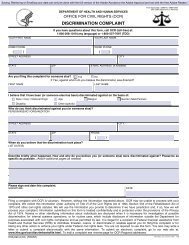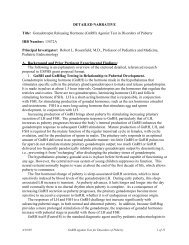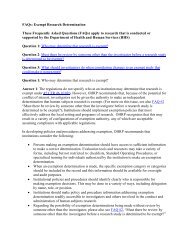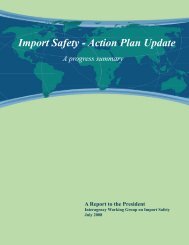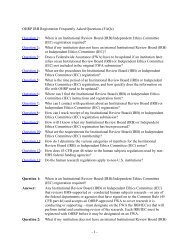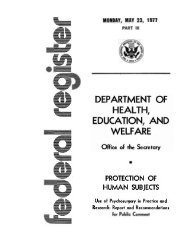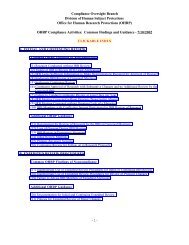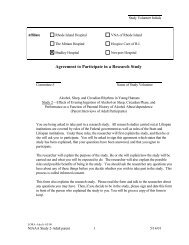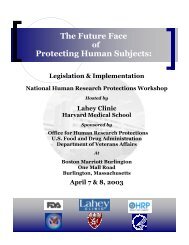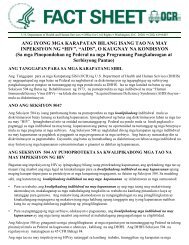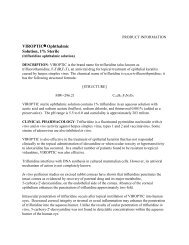OHRP 45 CFR part 46 Frequently Asked Questions ... - HHS Archive
OHRP 45 CFR part 46 Frequently Asked Questions ... - HHS Archive
OHRP 45 CFR part 46 Frequently Asked Questions ... - HHS Archive
- No tags were found...
Create successful ePaper yourself
Turn your PDF publications into a flip-book with our unique Google optimized e-Paper software.
<strong>OHRP</strong> <strong>45</strong> <strong>CFR</strong> <strong>part</strong> <strong>46</strong> <strong>Frequently</strong> <strong>Asked</strong> <strong>Questions</strong> (FAQs)Question 1: What is the historical basis for the current human research regulations, <strong>45</strong> <strong>CFR</strong><strong>part</strong> <strong>46</strong>?Question 2: What human research issues are addressed in <strong>45</strong> <strong>CFR</strong> <strong>part</strong> <strong>46</strong>?Question 3: How can I find out if the <strong>45</strong> <strong>CFR</strong> <strong>46</strong> human subject research regulations apply tomy research?Question 4: How does <strong>HHS</strong> ensure that regulatory requirements for human research are met?Question 5: Do the human research regulations apply to non-U.S. institutions?Question 6: How does <strong>45</strong> <strong>CFR</strong> <strong>part</strong> <strong>46</strong> relate to the Common Rule and human subjectsregulations used by non-<strong>HHS</strong> agencies?Question 7: How do sub<strong>part</strong>s B, C, and D of the <strong>HHS</strong> human research regulations at <strong>45</strong> <strong>CFR</strong><strong>46</strong> relate to sub<strong>part</strong> A?Question 1:Answer:What is the historical basis for the current human research regulations, <strong>45</strong> <strong>CFR</strong><strong>part</strong> <strong>46</strong>?The history of contemporary human subjects protections began in 1947 with theNuremberg Code, developed for the Nuremberg Military Tribunal as standards bywhich to judge the human experimentation conducted by the Nazis. The Codecaptures many of what are now taken to be the basic principles governing theethical conduct of research involving human subjects.Similar recommendations were made by the World Medical Association in itsDeclaration of Helsinki: Recommendations Guiding Medical Doctors inBiomedical Research Involving Human Subjects, first adopted in 1964 andsubsequently revised many times.Basic regulations governing the protection of human subjects in researchsupported or conducted by <strong>HHS</strong> (then the De<strong>part</strong>ment of Health, Education andWelfare) were first published in 1974. In the United States, a series of highlypublicized abuses in research led to the enactment of the 1974 National ResearchAct (Public Law 93-348), which created the National Commission for theProtection of Human Subjects of Biomedical and Behavioral Research. One ofthe charges to the National Commission was to identify the basic ethicalprinciples that should underlie the conduct of biomedical and behavioral researchinvolving human subjects and to develop guidelines to assure that such researchis conducted in accordance with those principles. In 1978, the Commissionpublished “Ethical Principles and Guidelines for the Protection of HumanSubjects of Research,” also known as the Belmont Report , named after theBelmont Conference Center where the Commission met when drafting the report.The Belmont Report identifies three fundamental ethical principles for all humansubjects research—respect for persons, beneficence, and justice.- 1 -
Based on the Belmont Report and other work of the National Commission, <strong>HHS</strong>revised and expanded its regulations for the protection of human subjects in thelate 1970s and early 1980s. The <strong>HHS</strong> regulations are codified at <strong>45</strong> <strong>CFR</strong> <strong>part</strong> <strong>46</strong>,sub<strong>part</strong>s A through D. The statutory authority for the <strong>HHS</strong> regulations derivesfrom 5 U.S.C. 301; 42 U.S.C. 300v-1(b); and 42 U.S.C. 289.The regulations found at <strong>45</strong> <strong>CFR</strong> <strong>part</strong> <strong>46</strong> are based in large <strong>part</strong> on the BelmontReport and were written to offer basic protections to human subjects involved inboth biomedical and behavioral research conducted or supported by <strong>HHS</strong>. In1991, 14 other Federal de<strong>part</strong>ments and agencies joined <strong>HHS</strong> in adopting auniform set of rules for the protection of human subjects, identical to sub<strong>part</strong> A of<strong>45</strong> <strong>CFR</strong> <strong>part</strong> <strong>46</strong> of the <strong>HHS</strong> regulations. This uniform set of regulations is theFederal Policy for the Protection of Human Subjects, informally known as the“Common Rule.” In 1995 the Central Intelligence Agency was required byExecutive Order to comply with all sub<strong>part</strong>s of the <strong>HHS</strong> regulations.Question 2: What human research issues are addressed in <strong>45</strong> <strong>CFR</strong> <strong>part</strong> <strong>46</strong>?Answer: <strong>HHS</strong> regulations at <strong>45</strong> <strong>CFR</strong> <strong>part</strong> <strong>46</strong> stipulate substantive and proceduralrequirements for investigators and institutions engaged in <strong>HHS</strong>-supported or -conducted research. Specifically, in addition to providing definitions andinformation about application of the regulations, specific sections of theregulations address the following topics:• Assuring compliance with the regulations (<strong>46</strong>.103)• Institutional Review Board (IRB) membership (<strong>46</strong>.107)• IRB functions and operations (<strong>46</strong>.108)• IRB review of research (<strong>46</strong>.109)• Expedited review procedures for certain kinds of research involving nomore than minimal risk, and for minor changes in approved research(<strong>46</strong>.110)• Criteria for IRB approval of research, including minimizing risk, ensuringconfidentiality, and protecting vulnerable populations, (<strong>46</strong>.111)• Review by institution (<strong>46</strong>.112)• Suspension or termination of IRB approval of research (<strong>46</strong>.113)• Cooperative research (<strong>46</strong>.114)• IRB records (<strong>46</strong>.115)• General requirements for informed consent (<strong>46</strong>.116)• Documentation of informed consent (<strong>46</strong>.117)• Applications and proposals lacking definite plans for involvement ofhuman subjects (<strong>46</strong>.118)• Research undertaken without the intention of involving human subjects(<strong>46</strong>.119)• Evaluation and disposition of applications and proposals for research to beconducted or supported by a Federal De<strong>part</strong>ment or Agency (<strong>46</strong>.120)• Use of Federal funds (<strong>46</strong>.122)• Early termination of research support: Evaluation of applications and- 2 -
proposals (<strong>46</strong>.123)• Conditions (<strong>46</strong>.124)Additional protections for specific populations have been adopted by <strong>HHS</strong> (andother de<strong>part</strong>ments and agencies to a lesser extent), as follows:• Sub<strong>part</strong> B, Additional Protections for Pregnant Women, Human Fetusesand Neonates Involved in Research• Sub<strong>part</strong> C, Additional Protections Pertaining to Biomedical andBehavioral Research Involving Prisoners as Subjects• Sub<strong>part</strong> D, Additional Protections for Children Involved as Subjects inResearchQuestion 3:Answer:Question 4:Answer:How can I find out if the <strong>45</strong> <strong>CFR</strong> <strong>46</strong> human subject research regulations apply tomy research?<strong>HHS</strong> regulations at <strong>45</strong> <strong>CFR</strong> <strong>46</strong>.103(a) require that each institution engaged inhuman subjects research that is supported or conducted by <strong>HHS</strong> provide theOffice on Human Research Protections with a satisfactory Assurance ofCompliance to comply with the regulations, unless the research is exempt under<strong>45</strong> <strong>CFR</strong> <strong>46</strong>.101(b). The assurance identifies policies and procedures for theinstitution and describes the activities to which the regulations apply. You shouldcheck your institution’s Terms of Assurance to find out whether the regulationsapply to your research. In addition, you might want to consult <strong>OHRP</strong>’s decisioncharts at http://www.hhs.gov/ohrp/humansubjects/guidance/decisioncharts.htm.How does <strong>HHS</strong> ensure that regulatory requirements for human research are met?<strong>HHS</strong> employs many approaches to facilitate compliance with the regulations.First, through a system of IRB registration and assurances, <strong>HHS</strong> regulationsrequire institutions to commit to compliance with <strong>45</strong> <strong>CFR</strong> <strong>part</strong> <strong>46</strong> beforeinitiating <strong>part</strong>icipation in <strong>HHS</strong>-conducted or -supported research involvinghuman subjects. On behalf of the Secretary, <strong>HHS</strong>, the Office on Human ResearchProtections (<strong>OHRP</strong>) approves the terms of these written institutional assurances,which constitute binding commitments.In essence, <strong>OHRP</strong> holds accountable and depends on institutional officials,committees, researchers, and other agents of the institution to comply with theinstitution’s assurance and the regulations.In carrying out its oversight responsibility, <strong>OHRP</strong>’s Division of ComplianceOversight monitors compliance through not-for-cause compliance oversightsurveillance activities and for-cause compliance oversight evaluations ofallegations or indications of noncompliance with the regulations. <strong>OHRP</strong> has theauthority under Title IV of the Public Health Service Act (42 USC 281 et seq.) toinvestigate complaints about human subject protections in <strong>HHS</strong>-conducted or -funded research, as well as any other research covered by the institution’sAssurance of Compliance. <strong>OHRP</strong> also promotes compliance through its Division- 3 -
of Policy and Assurances, which provides policy and guidance documentspertaining to the regulatory requirements in <strong>45</strong> <strong>CFR</strong> <strong>46</strong>.Question 5:Answer:Question 6:Answer:In addition, through its Division of Education and Development, <strong>OHRP</strong> providesa multifaceted education program—including national conferences, researchcommunity forums, and a quality improvement program—all of which enhanceunderstanding of the regulations and what is necessary for compliance.Do the human research regulations apply to non-U.S. institutions?Yes, whenever non-U.S. institutions are engaged in non-exempt <strong>HHS</strong>-supportedor –conducted human subjects research, the regulations apply. Pleasesee: http://www.hhs.gov/ohrp/humansubjects/assurance/filasurt.htm#sectionb .How does <strong>45</strong> <strong>CFR</strong> <strong>part</strong> <strong>46</strong> relate to the Common Rule and human subjectsregulations used by non-<strong>HHS</strong> agencies?The current U.S. system of protection for human research subjects is heavilyinfluenced by the Belmont Report , written in 1979 by the National Commissionfor the Protection of Human Subjects of Biomedical and Behavioral Research.The Belmont Report outlines the basic ethical principles in research involvinghuman subjects. In 1981, with this report as foundational background, <strong>HHS</strong> andthe Food and Drug Administration revised, and made as compatible as possibleunder their respective statutory authorities, their existing human subjectsregulations.The Federal Policy for the Protection of Human Subjects or the “Common Rule”was published in 1991 and codified in separate regulations by 15 Federalde<strong>part</strong>ments and agencies, as listed below. The <strong>HHS</strong> regulations, <strong>45</strong> <strong>CFR</strong> <strong>part</strong> <strong>46</strong>,include four sub<strong>part</strong>s: sub<strong>part</strong> A, also known as the Federal Policy or the“Common Rule”; sub<strong>part</strong> B, additional protections for pregnant women, humanfetuses, and neonates; sub<strong>part</strong> C, additional protections for prisoners; and sub<strong>part</strong>D, additional protections for children. Each agency includes in its chapter of theCode of Federal Regulations [<strong>CFR</strong>] section numbers and language that areidentical to those of the <strong>HHS</strong> codification at <strong>45</strong> <strong>CFR</strong> <strong>part</strong> <strong>46</strong>, sub<strong>part</strong> A. For all<strong>part</strong>icipating de<strong>part</strong>ments and agencies the Common Rule outlines the basicprovisions for IRBs, informed consent, and Assurances of Compliance. The listbelow displays the agencies and de<strong>part</strong>ments that have signed onto the CommonRule and their <strong>CFR</strong> numbers.• Agency for International Development (22 <strong>CFR</strong> <strong>part</strong> 225)• Consumer Product Safety Commission (16 <strong>CFR</strong> <strong>part</strong> 1028)• De<strong>part</strong>ment of Agriculture (7 <strong>CFR</strong> <strong>part</strong> 1c)• De<strong>part</strong>ment of Commerce (15 <strong>CFR</strong> <strong>part</strong> 27)• De<strong>part</strong>ment of Defense (32 <strong>CFR</strong> <strong>part</strong> 219)• De<strong>part</strong>ment of Education (34 <strong>CFR</strong> <strong>part</strong> 97 sub<strong>part</strong> A)• De<strong>part</strong>ment of Energy (10 <strong>CFR</strong> <strong>part</strong> 7<strong>45</strong>)• De<strong>part</strong>ment of Health and Human Services (<strong>45</strong> <strong>CFR</strong> <strong>part</strong> <strong>46</strong> sub<strong>part</strong> A)• De<strong>part</strong>ment of Housing and Urban Development (24 <strong>CFR</strong> <strong>part</strong> 60)- 4 -
• De<strong>part</strong>ment of Justice (28 <strong>CFR</strong> <strong>part</strong> <strong>46</strong>)• De<strong>part</strong>ment of Veterans Affairs (38 <strong>CFR</strong> <strong>part</strong> 16)• De<strong>part</strong>ment of Transportation (49 <strong>CFR</strong> <strong>part</strong> 11)• Environmental Protection Agency (40 <strong>CFR</strong> <strong>part</strong> 26)• National Aeronautics and Space Administration (14 <strong>CFR</strong> <strong>part</strong> 1230)• National Science Foundation (<strong>45</strong> <strong>CFR</strong> <strong>part</strong> 690)In addition, the Central Intelligence Agency must comply with all sub<strong>part</strong>s of <strong>45</strong><strong>CFR</strong> <strong>part</strong> <strong>46</strong> under Executive Order 12333.Question 7:Answer:Several non-<strong>HHS</strong> federal de<strong>part</strong>ments and agencies have additional regulations inplace for research involving special populations or for human subjects research ingeneral. Investigators are encouraged to review the regulations of the fundingagency to determine whether additional regulations apply. Also, many agencieshave not adopted sub<strong>part</strong>s B, C, or D and grantees of those agencies are notnecessarily bound by them. Grantees should consult their funding agency forguidance.How do sub<strong>part</strong>s B, C, and D of the <strong>HHS</strong> human research regulations at <strong>45</strong> <strong>CFR</strong><strong>part</strong> <strong>46</strong> relate to sub<strong>part</strong> A?Sub<strong>part</strong>s B (additional protections for pregnant women, human fetuses, andneonates); C (additional protections for prisoners); and D (additional protectionsfor children) are regulations that supplement sub<strong>part</strong> A by providing additionalprotections for vulnerable subject populations. Investigators conducting <strong>HHS</strong>supportedresearch in these populations must comply with all of the requirementsof sub<strong>part</strong> A as well as the requirements of the relevant sub<strong>part</strong>. Institutions mayfurther choose to apply sub<strong>part</strong>s B-D to all research regardless of whether it is<strong>HHS</strong>-supported. Therefore, investigators should contact their relevantinstitutional officials to determine which sub<strong>part</strong>s apply to their specific researchproject.- 5 -




